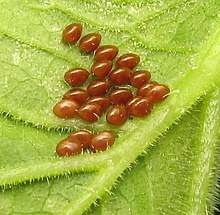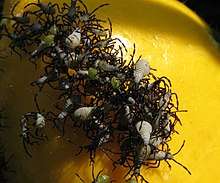Anasa tristis
Anasa tristis of the family Coreidae is a major pest of squash and pumpkins, found throughout North America, and is a vector of the cucurbit yellow vine disease bacterium.[1] These bugs can emit an unpleasant odor when disturbed. It is commonly known as the squash bug but shares this name with certain other species.
| Anasa tristis | |
|---|---|
| Nymphs on a squash plant | |
| Scientific classification | |
| Kingdom: | |
| Phylum: | |
| Subphylum: | |
| Class: | |
| Order: | |
| Infraorder: | |
| Superfamily: | |
| Family: | |
| Genus: | |
| Species: | A. tristis |
| Binomial name | |
| Anasa tristis (De Geer), 1773 | |


Description
The adult Anasa tristis is a greyish-brown, somewhat flattened insect reaching a length of about 1.5 cm (0.6 in) and a width of 0.75 cm (0.3 in). There is often a row of alternate brown and gold spots along the margin of the abdomen. Adults survive for three or four months.[2][3]
Host plants
Anasa tristis can be found on various members of the gourd family Cucurbitaceae, but most often occurs on pumpkins and squashes. Some varieties and cultivars are more susceptible to attack than others. Research has shown that nymphs can grow to adulthood with varying degrees of success on different host plants; 70%, 49%, 14%, 0.3% and 0% survived to maturity on pumpkin, squash, watermelon, cucumber and cantaloupe melon respectively.[3]
Life cycle
In the southern part of its range, the adult female Anasa tristis lays two or three batches of about eighteen eggs, but in the northern part of the range it just lays a single batch. The eggs are oval, somewhat flattened and bronze in colour, and are deposited on the underside of the leaves of the host plant. They may be clustered close together or more widely dispersed but are often regularly arranged. The eggs hatch after seven to nine days into nymphs which have five instar stages. The first instar nymphs are green and about 2.5 mm (0.1 in) in length. Each successive instar is larger and less hairy and grey. The fifth instar is grey, with developing wing pads and about 10 mm (0.4 in) in length. The complete nymphal stage lasts about 33 days.[3]
Damage
Anasa tristis is a true bug that feeds by sucking sap, mainly from the leaves, but sometimes also the fruit. In the process of doing this the insects inject toxic saliva into the plant tissues which causes them to wilt, darken in colour and die. The heavier the infestation, the greater the damage to the plant. Sometimes one plant or part of a plant can be heavily attacked while surrounding plants are untouched.[3] Besides the direct damage their feeding causes to the plant, these insects can act as vectors for cucurbit yellow vine disease caused by the bacterium Serratia marcescens. This disease can kill the plants.[4]
References
- Arnold, 2001
- Mertz, Leslie (20 January 2016). "Squash Bugs Still Making Growers Crazy After All These Years". Entomology Today. Retrieved 29 March 2016.
- Capinera, John (1 March 1999). "Squah bug: Anasa tristis". Featured Creatures. IFAS. Retrieved 29 March 2016.
- Boucher, T. Jude (1 May 2005). "Cucurbit Yellow Vine Disease (CYVD) In Connecticut". University of Connecticut, Cooperative Extension System. Retrieved 30 March 2016.